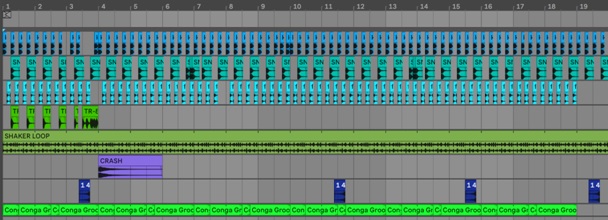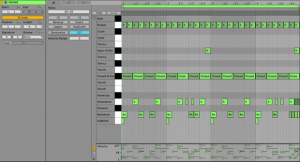Broadly speaking, there are two main approaches to programming drums in a DAW. As you’re about to see, the difference between the two comes down to choosing to work with Audio or MIDI tracks. Both paths can lead to the same results but entail contrasting workflows. In this article, we’ll give you a general overview of both methods.
Drum programming in Audio Tracks
Programming drums directly in audio tracks may seem straightforward to new DAW users because the process simply involves selecting samples and dropping them on the grid. It’s a visual way of producing drum lines because you can see the waveforms of each clip at all times. It can also facilitate the arrangement of your drums into a coherent song structure because everything is displayed in the grid. In addition, working with audio tracks allows you to access your DAW’s audio editing capabilities more quickly. Processes such as reversing, transposing and time-stretching samples are only one click away.

Audio-based drum programming in Ableton Live
Drum Programming in MIDI Tracks
In contrast, audio files can’t be dropped directly onto MIDI tracks. They require you to load a MIDI instrument (such as a sampler or a virtual synthesizer) before you can create a pattern, which in turn needs to be created within MIDI clips. Moreover, the MIDI editor brings up a separate window from the rest of the grid. Although these extra steps may seem more complicated to beginners as opposed to dropping samples on the grid, audio tracks lack the versatility that MIDI offers. The MIDI editor allows you to quickly manipulate note placements, dynamics, and groove, among other parameters. Simply put, MIDI makes it easier for you to experiment with your patterns.
Likewise, working with MIDI allows you to record yourself “finger-drumming” a beat. This can help you to come up with new ideas for your music. It can also give a looser, more organic feel to your programmed drums, among other uses. In addition, MIDI tracks can make for a more organized project because an entire drum pattern can be contained in a single MIDI clip. You’re also not limited to audio effects. Ableton Live and other DAWs provide you with a broad range of interesting MIDI effects that can enhance your creativity.

Drum Programming in Ableton Live’s MIDI editor
Combining the two approaches
There is no right or wrong way of programming drums – just trust your ears and do whatever sounds good. That said, these approaches can always be combined. For example, you can start programming your drums in a MIDI track and eventually record them in an audio track. Similarly, you could take the opposite road and start programming drums directly on the grid, which you can later convert to MIDI. You can also use a combination of MIDI and audio tracks for different layers of your patterns. For instance, you could program a basic drum beat in a MIDI track and use a pre-recorded loop on top of it on a separate audio track. Experiment with drum programming in both MIDI and Audio tracks so that you get the most out of your DAW’s audio and MIDI capabilities.






 50 Industry Music Production Tips You Must Know
50 Industry Music Production Tips You Must Know




